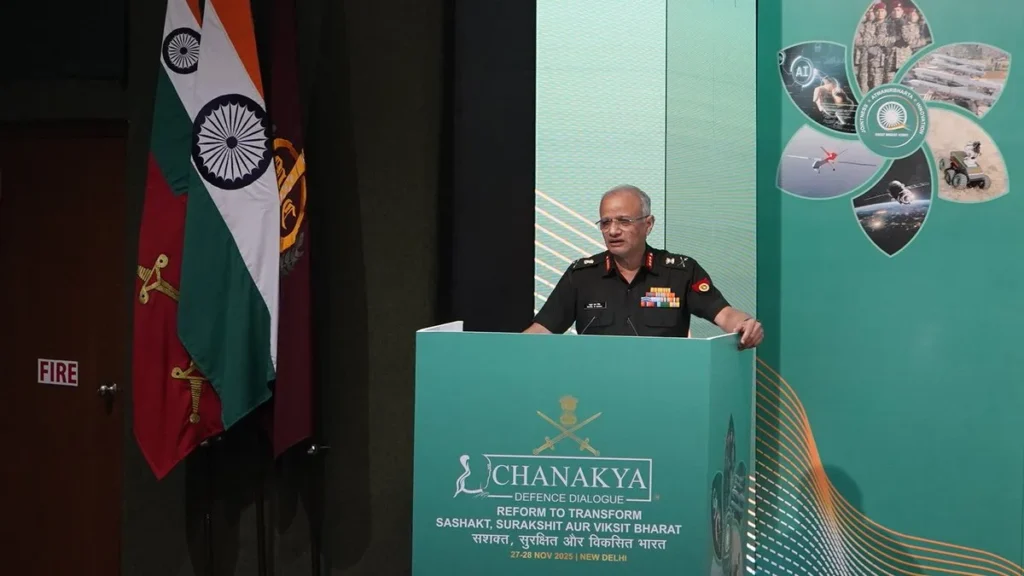The third edition of the Chanakya Defence Dialogue, held in New Delhi in late November 2025, was orchestrated to project an image of a “Strong, Secure, and Developed India.” However, the keynote address by Chief of Army Staff (COAS) General Upendra Dwivedi has triggered intense debate, with critics arguing that the narrative presented was less about factual security assessments and more about political rhetoric. While the Chanakya Defence Dialogue aimed to showcase deterrence, a rigorous fact-check of the General’s assertions regarding Kashmir, the “Operation Sindoor” conflict, and internal stability in Manipur reveals significant discrepancies that challenge the credibility of the official stance.
A primary point of contention at the Chanakya Defence Dialogue was General Dwivedi’s claim of a “huge decline” in terrorism in Jammu and Kashmir, attributed to “political clarity” post-August 2019. The General specifically asserted that 61% of the 31 terrorists killed in recent operations were Pakistani nationals, aiming to frame the unrest as solely foreign-sponsored. However, independent observers note that India has not provided detailed, verifiable dossiers to substantiate these numbers. Without independent verification, these assertions appear to be a selective framing designed to criminalize indigenous Kashmiri dissent by labeling it as purely Pakistan-backed terrorism.
This narrative obfuscates the ground reality of local alienation, evidenced by the April 2025 Pahalgam attack. Notably, while Indian authorities initially linked the attack to The Resistance Front (TRF), the group explicitly denied involvement, citing a cyber intrusion for the initial claim. The failure to acknowledge such complexities suggests the Chanakya Defence Dialogue was used to push a unilateral narrative rather than address core political disputes.
The Chanakya Defence Dialogue and “Provocative Posturing”
The General’s rhetoric concerning “Operation Sindoor” has also been criticized as dangerous, “provocative posturing.” Describing the intense cross-border exchange in May 2025 as “just a trailer” that “ended in 88 hours,” Dwivedi used the Chanakya Defence Dialogue to issue warnings of severe future responses. Critics argue that this trivializes a near-war scenario that required urgent diplomatic intervention to prevent nuclear escalation.
Furthermore, the claim of “efficient execution” with “no harm to innocents” is starkly contradicted by reports of civilian distress. Independent accounts and Pakistani officials have cited at least 31 civilian casualties, including women and children, during the Indian strikes. By ignoring these humanitarian costs, the narrative at the Chanakya Defence Dialogue risks fueling regional tensions rather than fostering the “responsible behavior” it demands of its neighbors.
The “Blood and Water” metaphor, reiterated by the General, referencing the suspension of the Indus Waters Treaty, further exemplifies this aggressive posture. By linking dialogue and water sharing to the cessation of alleged terrorism, the doctrine articulated at the Chanakya Defence Dialogue effectively weaponizes shared resources. Critics view this not as a tool of deterrence, but as a deliberate political instrument to justify withholding cooperation, thereby obstructing constructive diplomacy and undermining trust-building efforts in South Asia.
Deflection on Internal Security
Perhaps the most glaring “deflection” occurred when the General addressed the situation in Manipur. Speaking at the Chanakya Defence Dialogue, General Dwivedi claimed “significant improvement” in the state’s security since the imposition of President’s Rule. This assertion stands in sharp contrast to the reality on the ground.
Just days before the dialogue, on November 16, 2025, the state government was forced to impose a total internet blackout across seven districts following a resurgence of ethnic violence and the abduction of civilians. Highlighting sports events like the Durand Cup as proof of normalcy while suppressing digital communication is seen by analysts as an attempt to mask ongoing communal strife and governance failures.
In conclusion, while the Chanakya Defence Dialogue 2025 was intended to signal strategic confidence, the claims made by General Upendra Dwivedi face serious credibility challenges. From unverified statistics on foreign terrorists to the denial of internal crises in Manipur, the official narrative appears disconnected from the empirical realities. Rather than resolving conflicts, the rhetoric employed at the Chanakya Defence Dialogue suggests a reliance on coercive posturing that may deepen regional instability and alienate local populations further.



